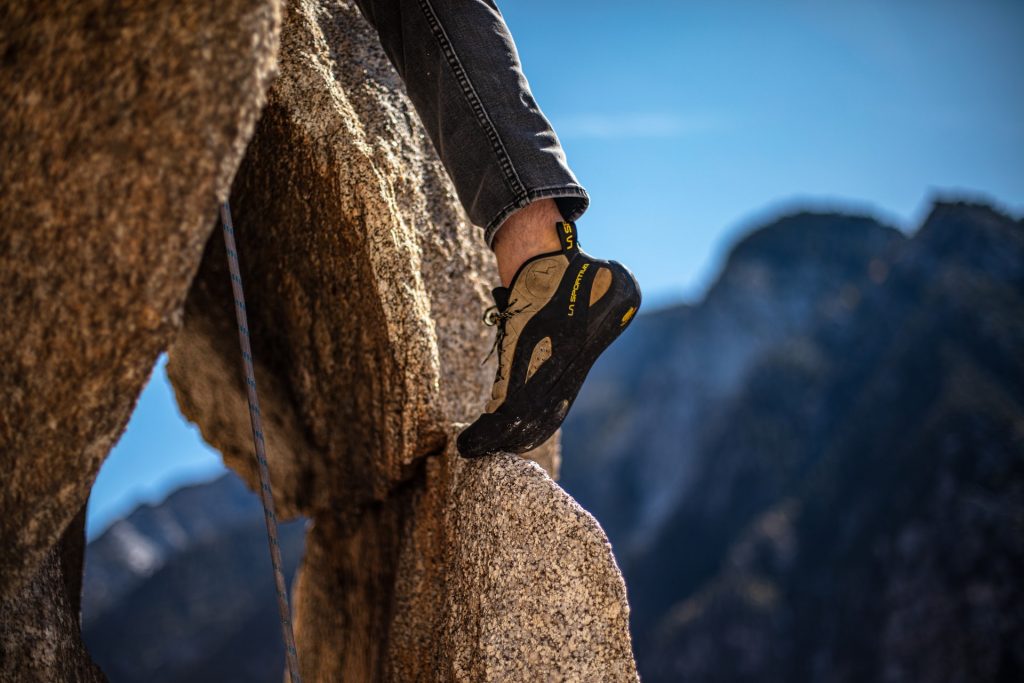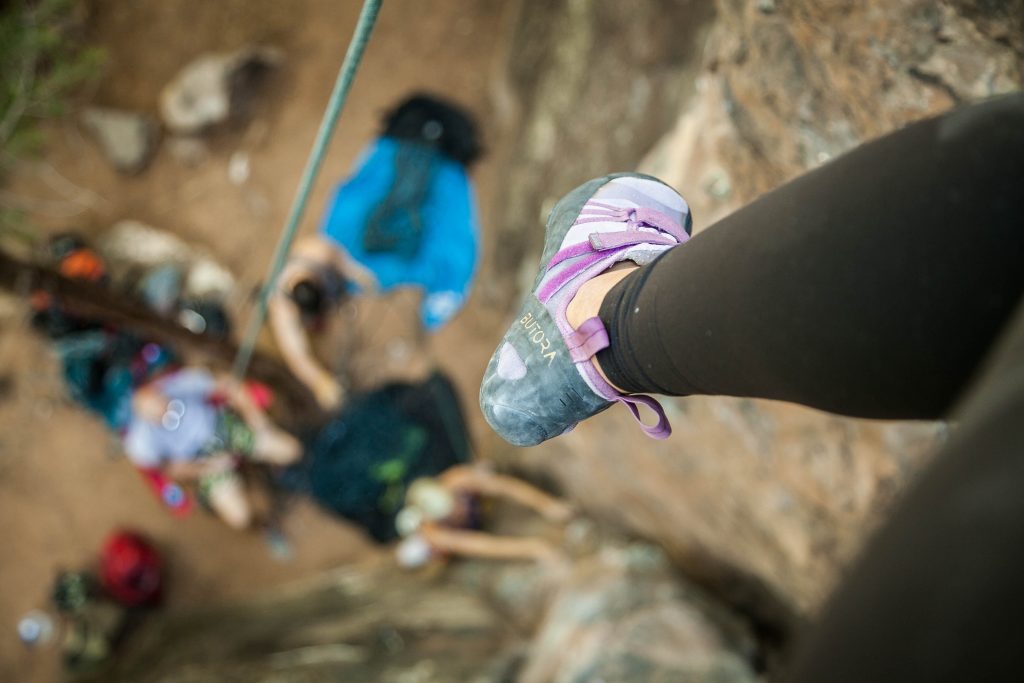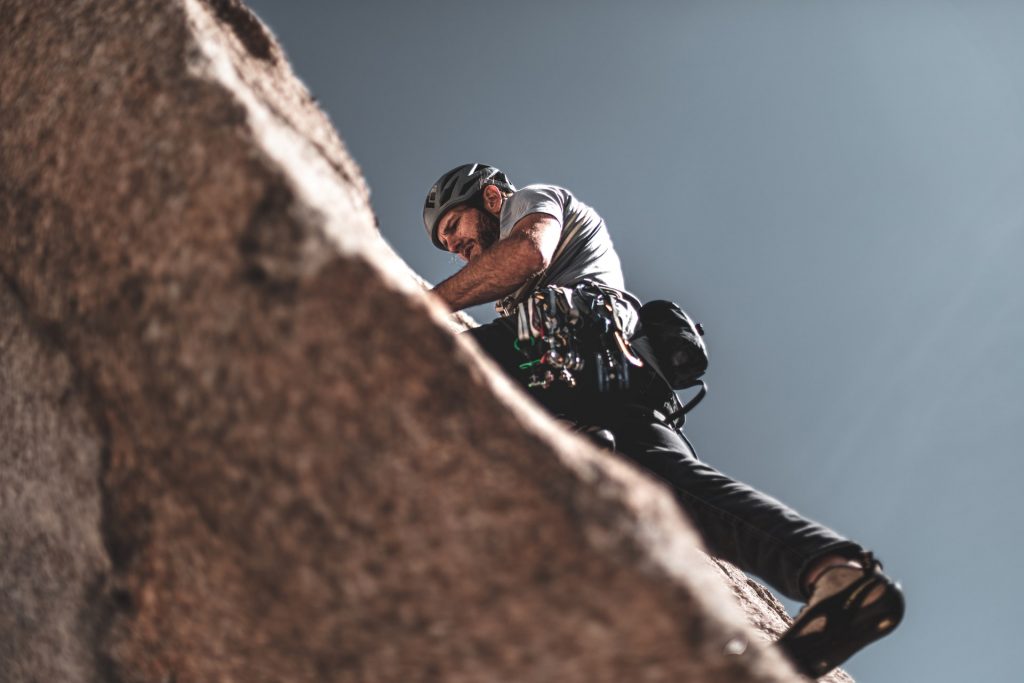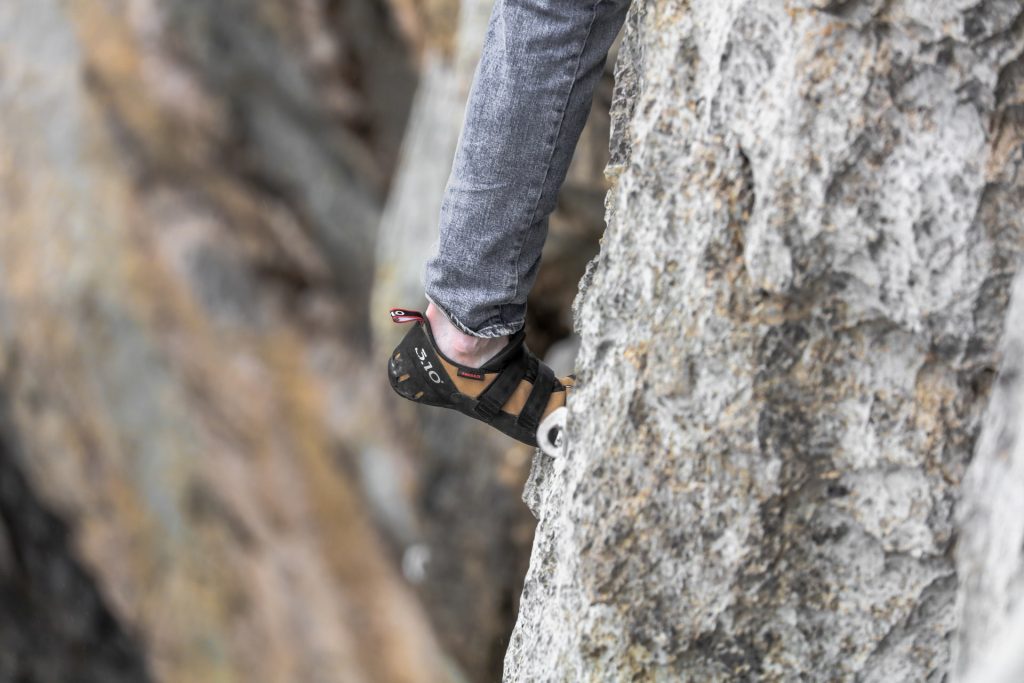Rock climbing shoes are very sensitive gear for rock climbers. If you want to enjoy the benefit of climbing with your own favorite shoes, there is no doubt that you need to stretch climbing shoes well so that your shoes become comfortable and fit as ideal.
It’s only natural that brand-new climbing shoes should feel tight on the feet. This is because the leather used to make these types of shoes has not been worn yet. Over time, this leather will become softer and more comfortable to wear.
Even a slight change in the amount of space in the shoe can make a big difference when you are up on the wall. You want to squeeze through tiny cracks and stand on small friction holds with maximum precision. If your shoes are even slightly too small, this won’t be possible.
So, how to stretch rock climbing shoes? Actually, it is a very easy job. Just read this article step by step, then do it yourself!
Table of Contents
2. Can I stretch my climbing shoes?

The short answer is yes. With a little effort and some care, you can stretch your climbing shoes to make them more comfortable. But there are some considerations:
The purpose of climbing shoes is to fit the shape of the user’s foot and enhance performance by providing sensitivity and a precise fit at crucial contact points on the shoe. A tight fit is critical for maximum performance in climbing; as such, fit is just as important as comfort when selecting a pair of climbing shoes.
As with any other shoe, your climbing shoes will “break-in” over time, but only if the fit is right. If the shoes are too tight, it will be impossible for them to stretch out and conform to your feet. They may even cut off circulation and cause blisters. On the other hand, climbing shoes that are too loose will not provide enough support or traction.
Type of Shoes You Own
If you want to stretch rock climbing shoes, first consider the type of shoe that you own. Climbing shoes come in different styles and sizes, so they will all have different levels of flexibility and durability.
If you have leather climbing shoes, I would suggest not stretching them too much. Leather shoes stretch more than synthetic materials, so they will get really floppy if you overdo it.
Leather shoes will stretch more than synthetic shoes because the leather fibers are longer and more flexible than synthetic fibers. If you have a pair of leather shoes that don’t fit well, you can create some extra room by stretching them.
The Direction That Needs To Be Stretched
Next, consider the direction that needs to be stretched. Climbing shoes come in different widths as well as lengths, so they may not fit perfectly when they’re new out of the box. The uppers may be too tight at the toes or heels or too loose around the ankles — any one of these issues could be improved by stretching your rock climbing shoes.
3. Do climbing shoes stretch?
Climbing shoes can be made from many different materials and designs, so there’s no universal rule about how much they will stretch. It’s important to note that climbing shoe leathers and materials don’t always respond the same way to stretching.
Some leathers stretch more easily than others, while some newer materials tend not to stretch at all. Even within one brand or model of shoe, there will be some variation in how much your specific pair will stretch.
Leather shoes stretch more than synthetic shoes because the leather fibers are longer and more flexible than synthetic fibers.
4. How much will climbing shoes stretch?
Climbing shoes are built with a certain amount of flexibility in mind. This is because you need to be able to move your toes around to grip the rock, and you need your foot to be flexible enough so that it can bend at the toes instead of having them locked into place like a stiff shoe would.
How much will climbing shoes stretch?
The amount of stretching varies from shoe to shoe, but most climbing shoes will only stretch about half a size after you’ve broken them in. Some shoes won’t even stretch at all. The more sensitive the material used for the upper fabric, the less it’ll be able to stretch before failing.
Each material used in construction (like leather or synthetic) has its own level of flexibility and durability; some materials will hold their shape better than others so make sure to check the specs before buying pair of climbing shoes that might not work for your needs!
5. Can you stretch synthetic climbing shoes?
The short answer is yes!
Synthetic climbing shoes stretch less than leather climbing shoes, they do stretch a little bit. so, Most manufacturers recommend that you wear your new climbing shoes for a few days to break them in before you start climbing.
The best way to stretch them out is to climb in them. You can also put them on and walk around in them for a while before you go climbing. the more you climb in your new pair of shoes, the more they will conform to your feet.
However, they may not stretch enough. the best solution is to try one of the methods mentioned in this article.
6. How long does it take to break in climbing shoes?
Break-in is a process that varies from shoe to shoe. For example, some shoes have a more aggressive shape than others, which means they’re going to take longer to break in than your average climbing shoe.
In general, if you buy a pair of climbing shoes that fits you well and has an aggressive shape, it should take weeks to break them in. But some people can be more sensitive than others and may need more or less time to break in their new shoes.
Breaking in climbing shoes takes time, but you can speed up the process by wearing them around the house for a few days before you head out to climb. This will help stretch out the leather uppers and get your feet used to how they feel on your feet. You should also try climbing in them as much as possible during this time period so they don’t become uncomfortable while you’re climbing.
7. How Tight Should Climbing Shoes Be?
The tightness of climbing shoes is an important and often misunderstood aspect of rock climbing. Climbing shoes must be tight enough to support your foot and help you stand on small holds, but not so tight that they squeeze and restrict your circulation.
The proper fit for rock climbing shoes will depend on the kind of climbing you do, how much you weigh, how flexible your feet are, and the shape of your foot.
The best way to determine whether a pair of climbing shoes fit properly is by trying them on while standing up, as this allows you to get an idea of how they will feel when you are actually climbing. to determine the right fit is to try on different sizes of climbing shoes until you find one that fits comfortably and provides adequate support for your foot.
8. Things to avoid when stretching Rock Climbing Shoes
- Don’t use any devices that might cause damage to the leather or rubber.
- Don’t use chemicals on the leather or rubber of the rock climbing shoes.
- Don’t put too much pressure on the shoe when stretching it out; this could cause permanent damage to your rock climbing shoes!
- Do not put your Rock Climbing Shoes in the washing machine that might cause damage to the shoe.
- Do not use any abrasive cleaning products on your Rock Climbing Shoes.
What is the best way to stretch climbing shoes?

Stretching your rock climbing shoes is vital for a good fit. If you don’t stretch your climbing shoes, there’s hardly any chance for you to wear them efficiently. People who regularly climb know that a great pair of climbing shoes can make all the difference in the world, which makes buying new shoes pretty regular. Here are my steps on how to stretch rock climbing shoes; read on…
1- Walk around in your shoes
The best way to stretch your climbing shoes is to walk around in them. the key to this method is to wear the shoes for a little while before climbing in them. The more time you spend walking around with them, the better they’ll stretch out.
Wear them as often as possible while walking around or doing other activities, this will help stretch out the leather and make it more comfortable.
You should also break into your shoes gradually. then gradually increase your time. This will give your feet time to get accustomed to the shoe’s shape and feel, and so that you don’t get blisters from too much friction.
Climb in your shoes
The best way to break in rock climbing shoes is by actually climbing in them. You’ll find that as you climb, your feet will naturally conform to the shape of the shoe as well as stretch it out over time.
2. Stuffing Climbing Shoes

1- Stuff the shoes with newspaper.
Climbing shoes are designed to be tight-fitting. This is necessary in order to provide the maximum amount of support and sensitivity needed by climbers. However, when you buy your first pair of climbing shoes you may find that they’re too tight. If this is the case, follow these steps to stretch them out:
You can stretch climbing shoes by stuffing them with newspaper. this will help mold them to your foot, making them more comfortable and giving you a better fit. then tie off the laces at the top of the shoe and leave them overnight. Climbing shoes remain loose instead of tightening back up, so after a day or two, they should be pretty much “broken in” and ready to go.
If you haven’t done this before, it may seem weird at first, but it works! Climbing shoe manufacturers recommend this method because it helps form the shoe around your foot as no other method can.
2. The plastic bag method
If you want to stretch your climbing shoes, fill them with plastic bags of water.
Take the plastic bags and fill them with water until they are about half full. Then, tie them off at the top so that no water can leak out. Place one bag in each shoe and let sit overnight.
The water will expand into every nook and cranny of the shoe, stretching it out so it fits your foot perfectly. You’ll have to repeat this process if you wear the shoes often, but it’s worth it!
Remove excess water from inside the shoe by gently squeezing its sides until most of the water is gone. You may need to repeat this step several times before all excess liquid has been removed from inside the shoe.
Stuff paper towels into each shoe to absorb any remaining moisture left over
3. Stuff Your Climbing Shoes with Socks
Stuffing your climbing shoes with socks or other soft materials helps them adapt to your foot shape faster and relieves pressure points that cause pain in your toes, heels, or arches. Stuffing shoes also helps prevent hot spots from developing between the two outer edges of the shoe’s toe box.
Stuff your climbing shoes with socks. This is probably the easiest way to make your climbing shoes fit better, especially for those who have narrow feet or high arches. Put in as many socks as possible until you get the desired fit — but don’t overdo it! You want enough room in the toe box so that your toes aren’t compressed.
3. The Freezer Method
1. The most common way to stretch climbing shoes is by putting them in the freezer overnight or for about 10 hours (depending on the material), The idea is that this will make the leather more pliable and therefore easier to stretch. making it easier for your foot to slide into them without resistance from the walls of the shoe.
2. Remove the shoes from the freezer and thaw out for about 30 minutes or until they are comfortable enough to put on again. This is important because if you try to stretch them too quickly, they will break at the seams. If necessary, repeat this process until you achieve the fit that you want.
3. If necessary, repeat this process until you have achieved the desired fit. after that, you can Put on your newly-stretched shoes and climb!
4. The Heat Method
Shoes can become uncomfortable if they’re not properly broken in. Breaking in a new pair of shoes can take days or even weeks, depending on the material and thickness of the shoe. Heating your shoes lightly with a hair dryer can help speed up the breaking-in process.
1. Turn on the hair dryer and set it to low heat. Heat your shoes for about five minutes, then let them cool down for another 10 minutes.
2. Repeat this process until you have thoroughly warmed up all parts of the shoe, including the tongue and heel area. Check to make sure there are no hot spots or burning sensations when you touch your shoe with your hand once it has cooled down again after being heated by the hair dryer. This will ensure that all parts of your shoe are evenly warmed up so they break in more quickly and comfortably than they would without heating them at all.
The reason why this works is that heat causes the expansion of materials, so when you put your shoe back on after heating it up with a blow dryer, it will expand slightly in size and become more comfortable to wear.
5. The Water Method

Soak your climbing shoes in a basin of hot water.
Soak your climbing shoes in a basin of hot water. This will soften the leather and make it more pliable
When your shoes are soaked, put them on and wear them for a few minutes to let them dry. Then take them off and put them back into the hot water for another 10 minutes or so. This is a great way to ensure that the leather is completely soaked through with water.
You can repeat this process as many times as you want, but I recommend at least once if you want to make a permanent difference in the comfort level of your climbing shoes.
Take Care When Wearing Soaked Shoes
After soaking your climbing shoes, take care when putting them on because they’ll be slippery on hard surfaces like concrete or tile floors. You may even want to put on some sort of shoe covers before wearing wet shoes out of the house or climbing gym — although this isn’t necessary if it’s just for walking around indoors where there are no slippery surfaces such as tile floors.
Check out our selection of climbing tips below::
35 Best Rock Climbing Tips For Beginners
How To Find Climbing Partners?
Conclusion
Steve Bechtel, renowned climbing expert and author of many books on the topic, once famously said, “Your shoes are soft…when you first get them. If you’re not willing to put in the time to break them in, then maybe climbing isn’t for you.” While this is certainly true, it can be quite a task to break in your new pair of shoes without assistance. Thankfully, there are a couple of tricks and techniques that you can use to loosen up leather shoes so they fit better and feel more comfortable during those all-important warmups.










Discussion about this post